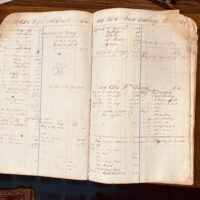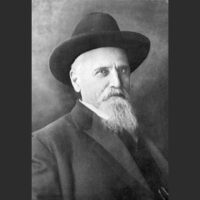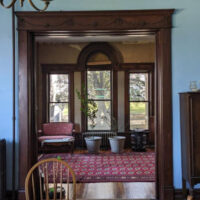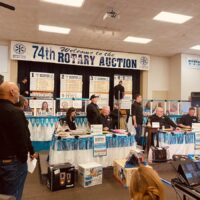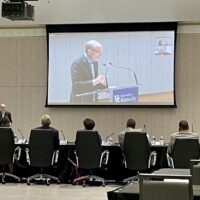This rectangular artifact measures 5.25 inches by 8.25 inches, and it contains approximately 60 pages. Showing years of wear and tear, the cover features a cardinal perched on a branch with a title embossed in gold: “The Cardinal Cat and Other Verse” by Mary Kimbrough Stoner.
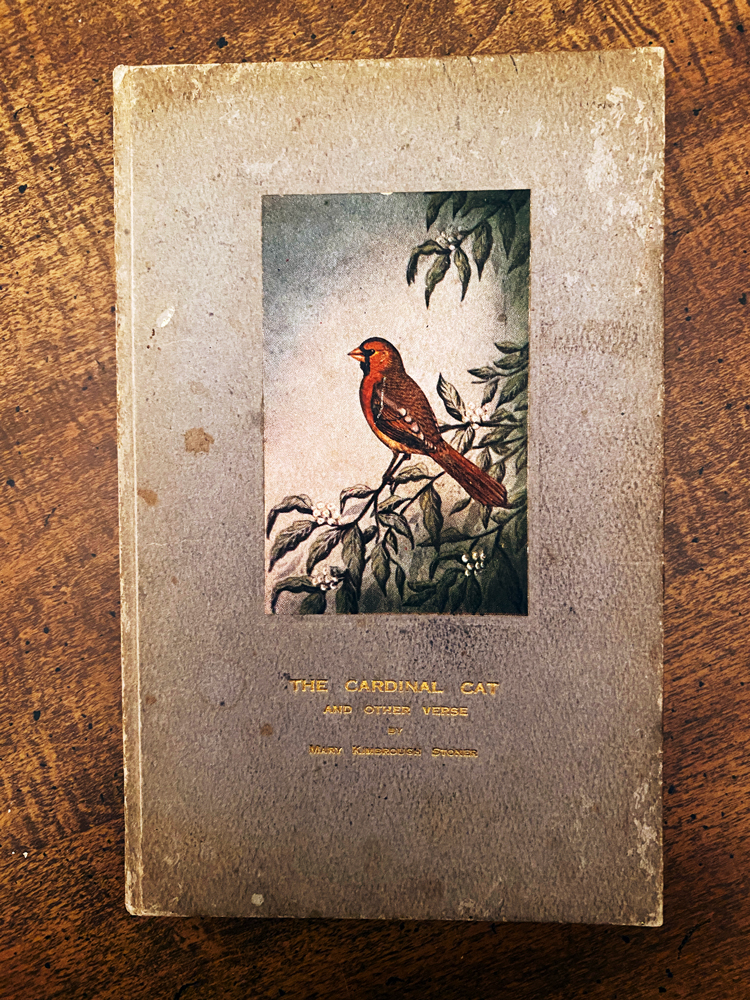
This month, I share with you a book of poetry.
I have the opportunity to share this book of poetry with you because Jennifer P. Brown shared it with me. Just a couple of weeks ago, Jennifer sent me a picture from the book after discovering it on a shelf in her house and telling me she wanted to donate it to the museum. Her best guess is that she picked it up at a bookstore in Lexington – likely drawn to it because of its charming cover and the poem “Autumn in Hopkinsville” listed in the index in the front.
She asked if I knew anything about Mary Stoner. I did not, but I told Jennifer that I would look into her. And what I found feels worth sharing.
Mary Stoner’s early years
Mary Kimbrough Stoner was born in 1868 in Christian County, the youngest daughter of Peter Burris and Sara Ball Stoner. Her father, a wealthy farmer in the southeastern part of the county, was 67 years old when she was born. The 1870 census valued his estate at $40,000 – close to $1 million today. Peter married in 1822 and had at least five children with his first wife. After her death in 1841, he married Sara Ball and had at least four additional children. He died in 1874, when Mary was just 6 years old.
Mary Stoner, who never married, worked as a teacher for decades. According to an article in the Kentucky New Era after her death, she began her teaching career in South Christian.
A 1893 publication by the University of Chicago lists Mary as a divinity student and indicates she had graduated from Bethel College in Hopkinsville. We believe that after she was in Chicago she went to college in Staunton, Virginia, possibly at Mary Baldwin College, known in Mary’s day as Augusta Female Seminary. Following her graduation, she’d planned to travel abroad with some of her classmates, but her finances had run out. She returned home to teach in a small schoolhouse in the Howell community where she lived with Mrs. Sammie Fox at her farm on Cox Mill Road. She taught in the county for several years before she made a big move to Lexington.
Census records put Mary in Lexington at least by 1910 when she was 42 years old. She boarded in a house on Second Street with a widow, and her occupation was listed as a teacher. She boarded other places between 1910 and 1916 when city directories put her at 216 Lexington Ave. She lived at this address until her death in 1961.
A teacher, organizer and ‘keen businesswoman’
Mary taught in the public schools until about 1936. During her tenure as a teacher, she organized the first teacher pension system in the Lexington school system. She was noted as a keen businesswoman who purchased and accumulated several valuable properties in Lexington. Newspapers also mention Mary as part of the Lexington Story League, a group she frequently hosted in her home and with whom she shared her original poetry.
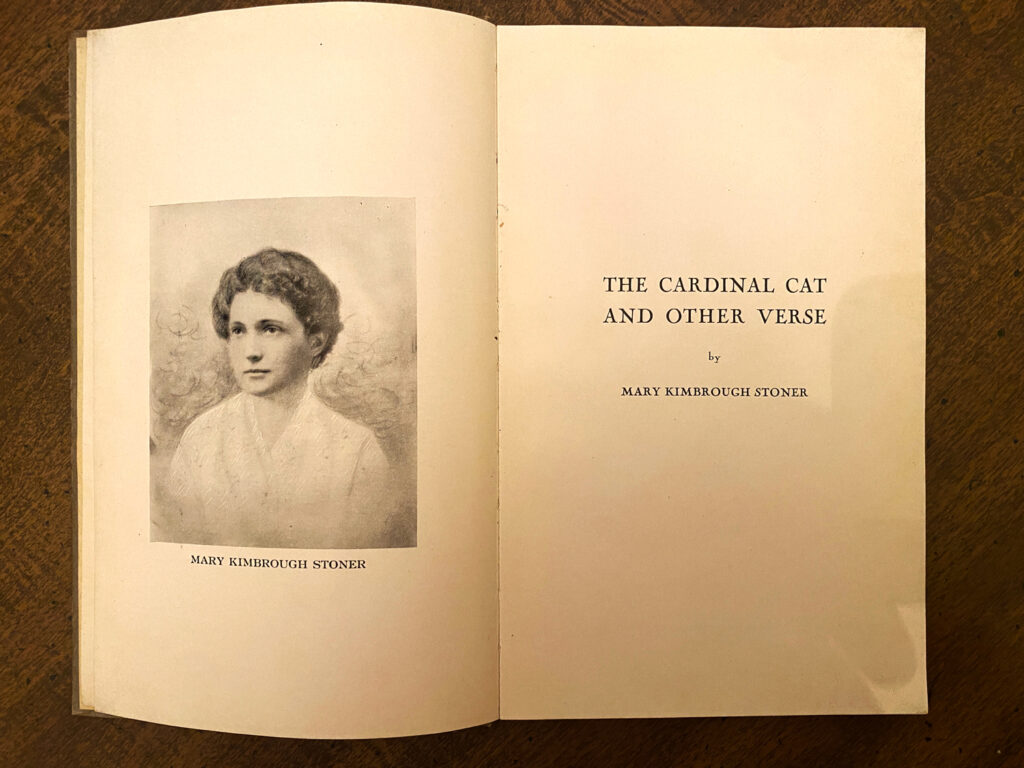
Which brings us back to this small book that Jennifer Brown found tucked away in her house. “The Cardinal Cat and Other Verse,” was self-published by Mary Kimbrough Stoner in 1941. It was printed by the Transylvania Printing Company in Lexington and contains 63 poems, 10 photographs, other illustrations, and even hand-drawn sheet music to accompany her poem “The Bogie Man.” This copy is signed.
Mary died on Nov. 10, 1961, at the age of 93. She left behind a large estate valued at approximately $275,000 – and no immediate survivors. Her will provided distributions to nephews, nieces and friends, with the remainder of her estate – about $150,000 (or $1.5 million today) – to be placed in a trust set up for Lexington city schools.
In her will, she stated, “As a former teacher in the city schools of Lexington, I appreciate the desirability of providing funds for the enhancement and enrichment of their educational programs, beyond the funds available to the Board of Education in the usual course and I have confidence that the Board of Education … will be able to formulate and carry out plans and projects which will be beneficial to the students in the school system.”
The story of Mary Kimbrough Stoner’s benevolent contribution to education was picked up by The Associated Press. Her name and news of her good deed were published from the Spokane Chronicle in Spokane, Washington, and the Press-Telegram in Long Beach, California, all the way to the Birmingham Evening Mail and the Lincolnshire Echo in England!
That’s quite the legacy to leave behind.
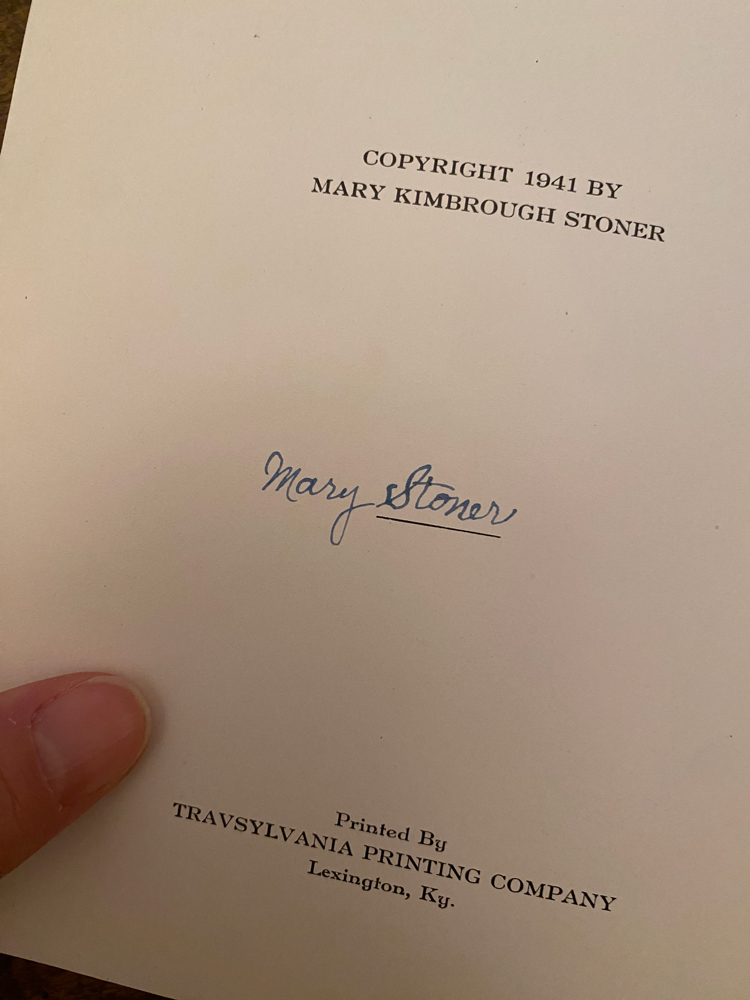
A legacy of words
We wouldn’t have known about this Christian Countian had it not been for the discovery of this small book of her poetry. She may have left behind a monetary legacy to Lexington, but she left us all with her words.
Poetry has a way of distilling feelings and observations using language in such a precise, intentional way. Every word choice makes a difference. At least, that’s one of the things that strikes me when I read poetry. I don’t read it often, but thanks to this year’s Big Read book selection – “Catalog of Unabashed Gratitude” by Ross Gay – I’m gaining a newfound appreciation for it.
On Nov. 16, 1941, the Lexington Herald ran a short story on its front page about Mary’s book. The book had been privately printed as Christmas gifts for her friends. The poems in the collection are about these friends, about nature, about people and places in Lexington, and about life. As I mentioned earlier, she wrote one about Hopkinsville. I’ll leave the final words to Mary, from Page 5:
Autumn in Hopkinsville
Whose maple beggars Canada.
Have you seen the dewdrops shining
Shining in display,
Shining in your pleasant rambles
Where the fragrant wild rose brambles
With the alder, cause you pining?
Soon the dew’s away
Soon i stone the brilliant shining,
Not allowed to stay.
Has your heart been faint with longing
At the close of day,
When the western sky is burning
With a flame that feeds your yearning?
On the thousand chams belonging?
Charms soon snatched away.
Though your heart is faint with longing
Sunset will not stay.
Has your heart been pained with throbbing
Throbbing on the day
When the rainbow arched its glory
Into part of your life’s story?
Then in smiling and in sobbing
Glides the bow away.
Though your heart is pained with throbbing
Rainbows may not stay.
Yet fate your longing will fulfill
One glad autumn day.
Dewdrops’, sunsets’, rainbows’, treasures
Have been saved in lavish measures
For autumn’s crown in Hopkinsville.
Treasures there hold sway,
There, fate your longing will fulfill
One glad autumn day.
